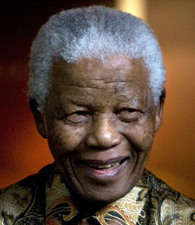Nelson Mandela was elected during the first election when South African blacks were allowed to vote. A leader of the resistance for years, Mandela was sentenced to life imprisonment, but was eventually released in order to negotiate the end of apartheid.
Nelson Mandela’s Early Days
Nelson Rolihlahla Mandela was born on July 18, 1918, in a small village near Umtata, Transkei. The son of the Paramount Chief’s principal councilor, Mandela became the ward of the chief when his father died. Mandela began his college education at the University College of Fort Hare, where he met Oliver Tambo. After being suspended for participating in a boycott, he moved to Johannesburg, where he joined the African National Congress in 1942. He joined Anton Lembede in forming a movement of young Africans in the ANC that emerged as the most influential anti-apartheid movement.
Mandela as Resistance Leader
Mandela and Tambo opened South Africa’s first black law practice in 1952, and focused on cases challenging the country’s apartheid laws. Mandela spent many years in various campaigns and nonviolent protests against the apartheid government, which tried to silence him. In 1956, he was “banned,” which limited where he could travel and what he could say, and then arrested for treason, though he was acquitted years later.
The ANC was outlawed by the government in 1960, forcing its leaders underground. Mandela adopted a number of disguises to dodge authorities, earning the nickname “the Black Pimpernel.” It was during his time underground that he determined that nonviolent protest was ineffective and that military action was necessary.
He helped form the militant wing of the ANC, called Umkhonto we Sizwe (MK), meaning “Spear of the Nation.” As the commander in chief of MK, Mandela organized bombing attacks on government targets.
He was arrested in 1962 and sentenced to five years in prison. A year later, the government discovered a stash of arms and attack plans at an ANC hideout in Rivonia. Charged with sabotage against the government and facing a possible death sentence, Mandela didn’t deny the charges against him, instead choosing to justify his resistance in a famous speech on the dock.
“I have cherished the ideal of a democratic and free society in which all persons live together in harmony and with equal opportunities,” he declared. “It is an ideal which I hope to live for and to achieve. But if needs be, it is an ideal for which I am prepared to die.”
Mandela was sentenced to life in prison and sent to Robben Island, a notorious prison and hard labor camp. In 1985, under intense domestic and international pressure to release Mandela and other ANC leaders, South African President P.W. Botha offered Mandela his freedom on the condition that he renounce violence. Mandela refused because “prisoners cannot enter into contracts.”
Sources in this Story
- NelsonMandela.org: Biography
- Encyclopedia Britannica: Nelson Mandela
- The Observer: The Rivonia Trial
- African National Congress: Toward Robben Island: The Rivonia Trial
- PBS: The Long Walk of Nelson Mandela
- The Tech (Los Angeles Times): Mandela Wins Free Election De Klerk Ready to Cooperate
- Nobel Peace Prize in 1993
- The BBC: Truth Commission report: At a glance
- Time: Nelson Mandela
- The Guardian: Mandela keeps his opinions to himself as a nation marks its idol’s birthday
Mandela as President
Mandela was released in February 1990, soon after the election of F.W. de Klerk. Joining forces with de Klerk, Mandela devised a strategy for transitioning out of the apartheid that earned the two the Nobel Peace Prize in 1993.
In May 1994, the first free elections to include both blacks and whites were held in South Africa. The ANC won 62 percent of the votes and Mandela was named president. He stood before the crowd and declared that it was “a joyous night for the human spirit.”
Toward the end of his presidency, Mandela established the Truth and Reconciliation Commission (TRC) to investigate the crimes committed by both sides during apartheid. During the investigations, it was discovdered Mandela’s wife Winnie was involved in numerous murders and allowed assault and mutilation to take place in her home.
Time magazine named Mandela one of its 100 greatest leaders in 1998. Although the magazine addressed the way in which Mandela, as president, struggled to live up to the mythic persona he generated in prison, author Andre Brink concluded, “Through his willingness to walk the road of sacrifice, he has reaffirmed our common potential to move toward a new age.”
The Man and His Work
- “Long Walk to Freedom”
- “In His Own Words”
- “Playing the Enemy: Nelson Mandela and the Game That Made a Nation,” by John Carlin
- “Nelson Mandela: Son of Africa, Father of a Nation” (DVD)
The Rest of the Story
Mandela served one five-year presidential term before retiring in 1999. He has since dedicated his life to speaking engagements and charity work. He had difficulty getting along with his successor, Thabo Mbeki, and a recent Mbeki biographer explained, “Mandela was treated like a difficult and bothersome old man who should go away.”
Robben Island, where Mandela spent 18 years, is now a museum and education center. While Mandela was there, he led an initiative to offer education for inmates. According to its Web site, “Robben Island came to symbolise, not only for South Africa and the African continent, but also for the entire world, the triumph of the human spirit over enormous hardship and adversity.”
This article was originally written by Rachel Balik; it was updated June 5, 2017.











